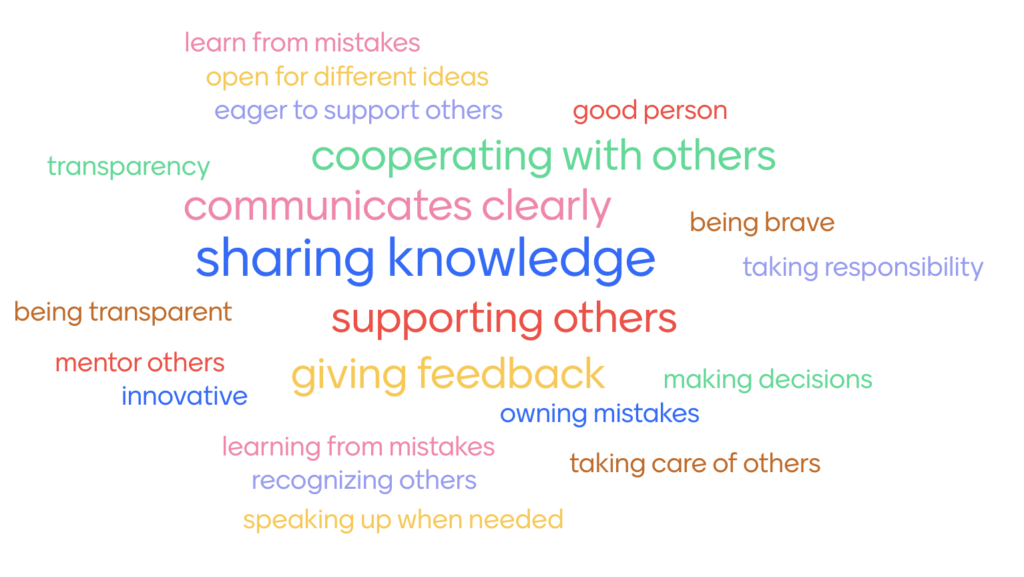Did you ever noticed that we teach leaders in countless growth programs, workshops, or mentoring processes how to be a great leader, and we almost never teach employees how to be great team members? To follow the TEAMING idea?
Why is that? Is it more important to have qualified leaders than people who know how to work well together? We know it’s not true. A part of successful leadership is to have a team that has an ability to cooperate effectively, ideally to like and understand each other as people.
During my post-grad studies in Transition Management area, one of the lecturers brought to the class a book named “Teaming: How Organizations Learn, Innovate, and Compete in Knowledge Economy” by Amy C. Edmondson. And while having a conversation about the teaming, people, communication and how it creates great (or not so great) organizations, I’ve started to wonder how all those dots are connected. How one thing influences the other and makes success or failure at the end of the day?
How to think about TEAMING: is it even the real thing?
What is TEAMING?
TEAMING is a mindset. Based on Amy’s book, TEAMING is more about “being” with others in a certain way than “doing” things. Of course, the behavior is an important part of the whole idea, so we can tell that “behaving” is “doing”. But it’s not the point.
The point is that TEAMING covers the way of working, behaving, making decisions in work environment where we don’t have a luxury of a stable team structures. Where individuals, teams, departments, and projects need to work together somehow, while the circumstances change all the time. So, TEAMING brings to the table collaboration based on an eagerness to learn, be better every day and communicate as well as possible, despite the constant change that never ends. And it never will, let’s be honest about it.
Do we ever think about the qualities of a good team member? We for sure can list very quickly the qualities of a good manager within 30 seconds. But how about team members? Recently, I did this exercise with one group of leaders that I facilitated the workshop for. I asked them to give 2-3 things that they believe are qualities of a great team member. The results came up like this.

So, as we can see, there are a lot of things connected with taking responsibility and do the job, but mostly there are things connected to “being” with others. A person who shares knowledge, taking care of other team members, listen, be brave, mentor others etc. Not many “transactional” elements are there as we can see. Interesting, isn’t’ it?
How to lead a TEAMING process?
As leaders, we have a lot of influence (more that we think we have) on how the work environment looks like for our people. Pretty often we don’t use this power because we don’t believe that it would work, we don’t know how to do it, or we are afraid that we’ll get different outcome from what we aim for by certain actions. We don’t believe that we can actually change something.
Leading in TEAMING means using the mindset that will allow people to be a better team member. It consists of three things:
- Encouraging speaking up. Creating space with high level of psychological safety, since without it, no one is going to speak up, ever. People need to feel that they won’t be judged, treated harshly by other team members. That they can tell what they think (of course from OK-OK space, with a good intention) and it can open an honest, interesting, and even groundbreaking discussion. The key thing is that they believe in not being snapped or punished for what they say or think.
- Ask questions and allowing people to ask them as well. If we are genuinely curious about what our people think, we ask questions, using active listening skill all the time. When our team members see that kind of behavior, they are going to model it by building their curiosity too. They will learn that there is no such thing as a stupid question: every question is fine, if it has a good background, intention and is honest. Allowing people doing that in a safe space will support them in their growth and will make them better in communication, innovation, creativity, and problem solving. By developing this skill, you “accidentally” develop few other ones, important and insightful for you and your team to succeed.
- Creating space for sharing ideas. It’s similar to making space to ask questions, but it goes one step further. One of the most important things for people in a workspace is autonomy. To make their own decisions, choose what’s right and wrong when it comes to the approach that they use to cover a certain task. To take responsibility for their careers and growth opportunities. And a part of autonomy is also bringing ideas to the table, discuss them with other people, and next: making idea owners responsible for moving further with execution once they are chosen to implement. Great atmosphere, like-minded people are crucial for those personality types that are more creative, visionary, but also for those who are more into data and facts, or relations with others.
A leader is responsible for creating a workspace for people to thrive. It’s all we need to do.
Why don’t we teach people how to be great team members?
It’s not very intuitive to start from teaching people about being a good team member. Definitively more classical way is to teach leaders how to be great and lead others successfully. But that way, we put all responsibility on the leader’s shoulders. I’m not saying that leader don’t need to grow, have certain set of skills, behaviors or mindset.
But when we think about improving the ability of being a great team member, we divide the responsibility into all people that making a team: manager AND team members. Both parties need to participate in the process of team creation: it influences the level of engagement, being in control and a part of something more than just my own scope.
Why don’t we do it more often? Maybe because it requires a mindset and approach shift, a creation of a new one to cover the different perspective. And it can be difficult, sometimes going far away into the stretch zone and recreate the growth options we have for people in the organization.
What do we need to make that shift?
- The idea what kind of change we would like to see in our team.
- Knowledge what kind of personality types we have the most visible in the team and based on that: what kind of TEAMING shift we can offer them to feel and think that’s a great idea?
- Preparation of a plan: what do we want to achieve here? Who is going to responsible for what in this new model? What kind of change we would like to see after implementing XYZ?
- Seeking for help in HR, L&D or external coach: find out with their help who had already done it, what was their approach, what are the lessons learned from implementation process. It can save a lot of time and effort in terms of looking for right answers and solutions.
- Working incrementally, using leading with agility approach. Implement one little thing, gather feedback, work with the team on it. Decide together if we stay with it or not, and then move on to another idea. Remember about the grieving change curve: the smaller the changes and the more people will be involved with them, the less negative emotions and resistance there will be on the road.
Wouldn’t it be more efficient, nice, and engaging to have more than one people who takes care of different team building elements? Imagine that we all are taking part in building the environment where people are highly motivated, performing very well, create space to give different ideas and have sparing partners to discuss them? Where we learn from each other, share knowledge and the best ways of working?
Sounds pretty cool to me. And for you?




